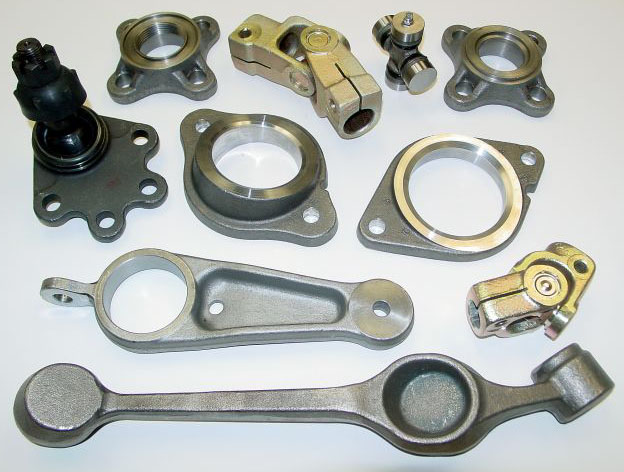Conventional heat treatment of
forgings is mostly such heat treatment of cooling forgings to room temperature and reheating them based on technological procedure. However,
quenching process by remaining heat from forging is such heat treatment of using remaining heat from forging for direct quenching so as to make full use of remaining heat. Relevant studies show that, compared with conventional heat treatment, mechanical properties of steel parts can be greatly improved after quenching process by remaining heat from forging. For instance, rigidity of steel parts can increases by 10%, tensile strength by 3%~10%, elongation by 10%~40% and impact toughness by 20%~30%. Besides, steel parts after such new heat treatment have excellent tamper resistance with strengthening effect of over 600°C.
Quenching process by remaining heat from forging requires relatively high heating temperature (usually 1050~1250°C) before quenching. The use of remaining heat from forging, resulting in no need of austenitizing reheating process of heat treatment (namely normalizing as well as quenching and high temperature tempering), is a very important heat treatment and energy saving method. Therefore, such heat treatment is widely applied in automobile parts like connecting rods, crankshafts, camshafts, etc.
Apart from simplifying production process and improving performance of forgings, quenching process by remaining heat from forging has the following characteristics: (1) saving energy: no need of normalizing as well as quenching and high temperature tempering can remarkably save energy due to adoption of this heat treatment; (2) saving steel materials: this heat treatment increases strength of steels so as to reduce mass and save steel materials; (3) shortening production cycle: because of simplifying production process and no need of normalizing as well as quenching and high temperature tempering, working hours can be significantly reduced; (4) facilitating machining operation: thermomechanical treatment is not easily popularized due to increased strength and rigidity as well as shape change of parts. Because forging rolling forming cannot ensure geometric accuracy of parts, machining operation is required after thermomechanical treatment. But increased strength and rigidity make subsequent machining operation more difficult. To overcome this difficulty, the said heat treatment and subsequent high temperature tempering for replacing original quenching and high temperature tempering can be adopted and the resulting strength and rigidity after high temperature tempering is not high, making machining operation easier. The heat treatment becomes a common thermomechanical treatment process and is widely applied in production.
Carbon content of important mechanical parts mostly belongs to hypoeutectoid steel category. Original process of such parts is: forging forming→normalizing→high temperature tempering→rough machining→quenching and high temperature tempering→fine machining. The new process of such parts is that remaining heat after forging forming can be used for quenching and high temperature tempering so as to replace original normalizing and quenching and high temperature tempering, namely: forging forming→quenching by remaining heat→high temperature tempering→rough machining→fine machining. Parameters of quenching process by remaining heat from forging have a great influence on strengthening effect, especially great impact from forging temperature as well as retention time after forging forming and before quenching, and are crucial to on-site work. With retention time becoming longer, rigidity, strength and impact toughness of steels decrease, so quenching should be carried out immediately after forging forming. Retention time of carbon steels can be 3~5s, while retention time of alloy steels can be longer. Generally speaking, retention time after forging forming and before quenching should be no more than 60s. Besides, deformation amount is helpful for improving rigidity and strength of forgings after quenching. The more deformation amount increases, the better strengthening effect becomes, especially multi-element low alloy steels.
Cold working dies or steels for cutting tools belong to hypereutectoid steel category. Their original process: forging forming→spheroidizing annealing→rough machining→quenching→low temperature tempering→fine machining. Spheroidizing annealing usually takes about 20h, consumes large amounts of electric power and generates relatively large spheroidized carbides with average diameter of over 1μm. Studies proves that the use of quenching process by remaining heat from forging and high temperature tempering can generate relatively small spheroidized carbides with average diameter of about 0.3μm and highly dispersed distribution property. It is well known that particle size of carbides and distribution state are one of major factors of affecting abrasion resistance of cutting tools and moulds. Quenching process by remaining heat from forging greatly improves abrasion resistance of cutting tools and moulds, thus prolonging their service life. Besides, rigidity after high temperature tempering is just slightly higher than spheroidizing annealing and has a little effect on machining operation. Hence, the use of quenching process by remaining heat from forging and high temperature tempering can be used as preheating treatment to replace spheroidizing annealing, thus saving electric power, reducing working hours and greatly improving utilization rate of equipment. Hence, new process of such said parts is: forging forming→quenching by remaining heat→high temperature tempering→rough machining→quenching→low temperature tempering→fine machining.
Quenching process by remaining heat from forging can improve quality of products, reduce working hours and save much energy. Besides, it can greatly shorten production cycle, significantly improve production efficiency, greatly reduce labour intensity of workers and bring remarkable economic benefits. Production practice has shown that this technique is worth popularizing. It is suitable for not only small batch production but also mass production.
